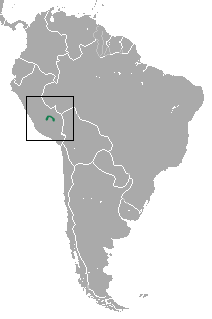
The Lacertidae are the family of the wall lizards, true lizards, or sometimes simply lacertas, which are native to Afro-Eurasia. It is a diverse family with at least 300 species in 39 genera. They represent the dominant group of reptiles found in Europe. The group includes the genus Lacerta, which contains some of the most commonly seen lizard species in Europe.

Asaccus is a genus of geckos, commonly known as Southwest Asian leaf-toed geckos, in the family Phyllodactylidae.

Eremias is a genus of lizards in the family Lacertidae, the wall lizards. They are native to Asia and southeastern Europe, where they live in desert and steppe regions.

The heavy-browed mouse opossum, or Anderson's mouse opossum, is a species of opossum in the family Didelphidae. It is endemic to a restricted range in southern Peru. This opossum inhabits forests; it is nocturnal and probably arboreal.
The Kurdistan leaf-toed gecko is a species of lizard belonging to the gecko family Phyllodactylidae. A. kurdistanensis is native to the Kurdistan province in western Iran and was described in 2006.
Eremias andersoni, also known commonly as Anderson's racerunner, is a species of lizard in the family Lacertidae. The species is endemic to Iran.

Asaccus elisae, also known as Elisa's leaf-toed gecko or Werner's leaf-toed gecko, is a species of gecko, a lizard in the family Phyllodactylidae. It is found in the Middle East, from southern Turkey through eastern Syria and northern and eastern Iraq to western Iran.
Acanthodactylus nilsoni, commonly called Nilson's spiny-toed lizard, is a species of lizard in the family Lacertidae. The species is endemic to Iran.
Natalie's Toad-headed Agama(Phrynocephalus ananjevae) is a species of agamid lizard endemic to the Zagros Mountains in Iran. The specific epithet honors Natalia Ananjeva of the Zoological Institute in St. Petersburg, Russia for her contribution to herpetological research of the family Agamidae and Phrynocephalus in particular.

Eremias persica, the Aralo-Caspian racerunner or Persian racerunner, is a species of lizard native to southern Azerbaijan, most of Iran, southern Turkmenistan, Afghanistan, and western Pakistan. Eremias intermedia is also known as the Aralo-Caspian racerunner.
Iranolacerta zagrosica, also known commonly as the Zagros Mountains lacerta, is a species of lizard in the family Lacertidae. The species is endemic to Iran.

Asaccus granularis is a species of leaf-toed gecko endemic to Iran. The specific epithet refers to the granular scales on the back of this lizard. It is only known from the type locality in Lorestan Province, Iran. It was found in a mountainous area with open oak forests, on rocky outcrops and under large boulders.
The Kermanshah leaf-toed gecko is a species of gecko endemic to Iran. It is named for the type locality, north of Kermanshah, eastern Kermanshah Province, in the Zagros Mountains of western Iran. It is found in caves and rock crevices at 1,400 m (4,600 ft).

Asaccus nasrullahi, Nasrullah's leaf-toed gecko, is a species of gecko in the family Phyllodactylidae. The species is endemic to Iran. The specific name nasrullahi was chosen in honor of Iranian herpetologist Nasrullah Rastegar-Pouyani, "in recognition of his contribution to the knowledge of the herpetology of Iran, including the genus Asaccus".
Asaccus tangestanensis is a species of leaf-toed gecko endemic to Iran. This gecko is found in the southern Zagros Mountains in Bushehr Province. It is found in cliffs and caves. The holotype was collected in 2008 and the species is named for Tangestan, the type locality.
Asaccus zagrosicus is a species of leaf-toed gecko endemic to Iran. The holotype was collected in 2008 in southern Lorestan in the Tang-e-Haft Region between the central Zagros Mountains and Khuzestan Plain.

The Persian snake skink is a species of skink endemic to Iran. A specimen collected in 1999 was found on sandy clay soil near Artemisia shrubs. It was originally described in 1867 as Hemipodion persicum.
Asaccus griseonotus, also known as the grey-spotted leaf-toed gecko or grey-marked gecko, is a species of lizard in the family Phyllodactylidae. It is found in Iraq and Iran.
Asaccus iranicus is a species of lizard in the family Phyllodactylidae. It is endemic to Iran.
Edwin Nicholas "Nick" Arnold, is a British herpetologist and former Curator of Herpetology at the Natural History Museum, London. Arnold made seminal contributions to the herpetology of Europe and North Africa, especially on geckos and lizards of the family Lacertidae. He discovered and described 36 species and 4 subspecies of reptiles, and wrote A Field Guide to the Reptiles and Amphibians of Britain and Europe, which appeared over multiple editions.







